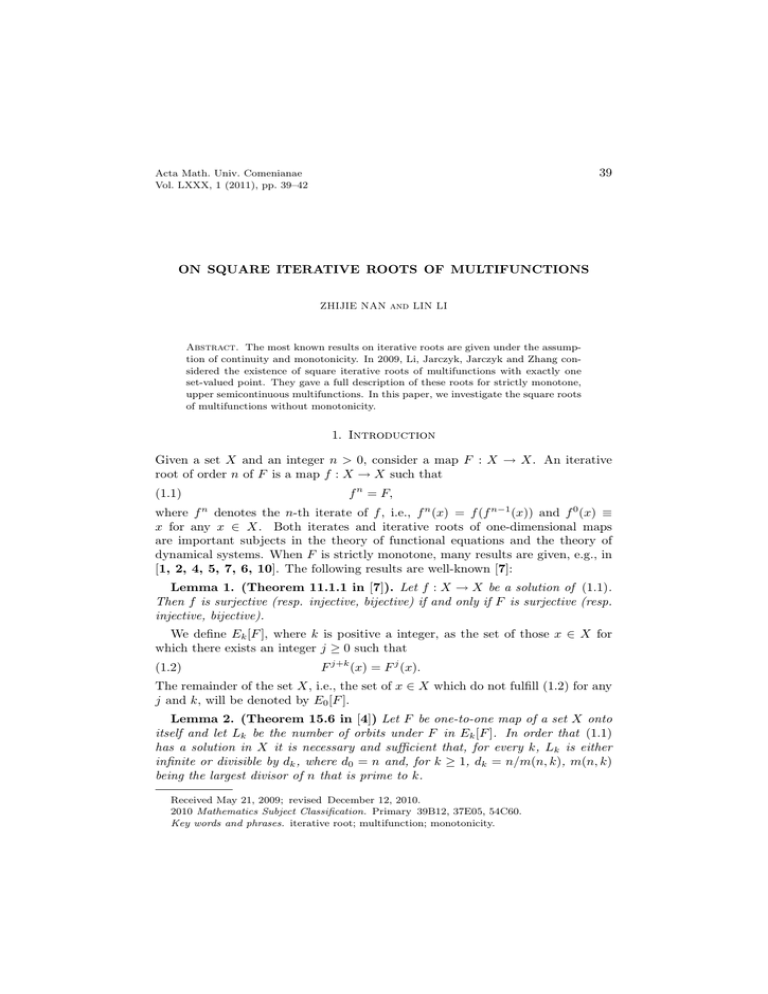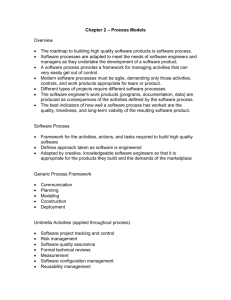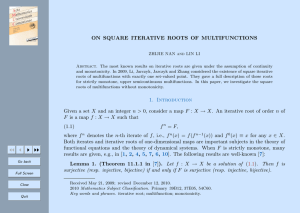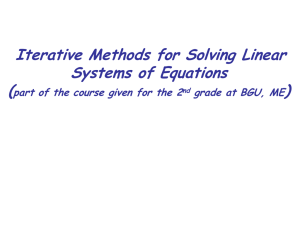39 ON SQUARE ITERATIVE ROOTS OF MULTIFUNCTIONS
advertisement

39
Acta Math. Univ. Comenianae
Vol. LXXX, 1 (2011), pp. 39–42
ON SQUARE ITERATIVE ROOTS OF MULTIFUNCTIONS
ZHIJIE NAN and LIN LI
Abstract. The most known results on iterative roots are given under the assumption of continuity and monotonicity. In 2009, Li, Jarczyk, Jarczyk and Zhang considered the existence of square iterative roots of multifunctions with exactly one
set-valued point. They gave a full description of these roots for strictly monotone,
upper semicontinuous multifunctions. In this paper, we investigate the square roots
of multifunctions without monotonicity.
1. Introduction
Given a set X and an integer n > 0, consider a map F : X → X. An iterative
root of order n of F is a map f : X → X such that
(1.1)
f n = F,
where f n denotes the n-th iterate of f , i.e., f n (x) = f (f n−1 (x)) and f 0 (x) ≡
x for any x ∈ X. Both iterates and iterative roots of one-dimensional maps
are important subjects in the theory of functional equations and the theory of
dynamical systems. When F is strictly monotone, many results are given, e.g., in
[1, 2, 4, 5, 7, 6, 10]. The following results are well-known [7]:
Lemma 1. (Theorem 11.1.1 in [7]). Let f : X → X be a solution of (1.1).
Then f is surjective (resp. injective, bijective) if and only if F is surjective (resp.
injective, bijective).
We define Ek [F ], where k is positive a integer, as the set of those x ∈ X for
which there exists an integer j ≥ 0 such that
(1.2)
F j+k (x) = F j (x).
The remainder of the set X, i.e., the set of x ∈ X which do not fulfill (1.2) for any
j and k, will be denoted by E0 [F ].
Lemma 2. (Theorem 15.6 in [4]) Let F be one-to-one map of a set X onto
itself and let Lk be the number of orbits under F in Ek [F ]. In order that (1.1)
has a solution in X it is necessary and sufficient that, for every k, Lk is either
infinite or divisible by dk , where d0 = n and, for k ≥ 1, dk = n/m(n, k), m(n, k)
being the largest divisor of n that is prime to k.
Received May 21, 2009; revised December 12, 2010.
2010 Mathematics Subject Classification. Primary 39B12, 37E05, 54C60.
Key words and phrases. iterative root; multifunction; monotonicity.
40
ZHIJIE NAN and LIN LI
For aSmultifunction f : X → 2X , its image f (A) of a set A ⊂ X is defined by
f (A) = x∈A f (x) and its n-th iterate f n by the composition of n copies of f
fn = f ◦ · · · ◦ f .
| {z }
n times
A point c ∈ X is called a set-valued point if the cardinal #f (x) > 1.
In [3], the authors discussed a class of multifunctions with lack of iterative
roots. And the existence of square iterative roots of monotone multifunctions
were considered in [8]. In this paper, we continue [3, 8] by concerning the purely
set-theoretical situation and investigate the square roots of multifunctions without
monotonicity.
In what follows, we consider a class of multifunctions F : X → 2X of the form
F1 (x),
if x ∈ X r {c},
(1.3)
F (x) =
M,
if x = c,
where c ∈ X, M ⊂ X and F1 is a bijection satisfying the sufficient condition of
Lemma 2. Define M ∗ = M r {c}. Clearly, M ∗ = M when c 6∈ M . Furthermore,
by Lemma 2, if F has a square iterative root, it should be in the form of (1.3).
Theorem 1. Let F : X → 2X be the form of (1.3) that is nearly bijective with
exceptional point c. If c 6∈ M , then F has a square iterative root. Otherwise, F
has a square root iff one of the following conditions satisfies
(1) f1 (M ∗ ) ⊆ M ∗ ,
(2) M ∗ ⊆ f1 (M ∗ ),
(3) M ∗ ∩ f1 (M ∗ ) = N ( M ∗ and f1−1 (N ) ∪ N = M ∗ ,
where f1 is a square iterative root of F1 and f (c) = M = M ∗ ∪ {c}.
Proof. Suppose that f1 is a square iterative root of F1 , which implies from
Lemma 1 that f1 : X r {c} → X r {c} is a one-to-one map.
In the case M = M ∗ , i.e., c 6∈ M , then F has an iterative square root f : X →
X
2 as followes.
f1 (x),
if x ∈ X r {c},
f (x) =
f1−1 (M ),
if x = c.
In the other case, i.e., c ∈ M , we note that c ∈ f (c). Based on this, we have
the following three subcases:
(3-1) M ∗ ⊆ f1 (M ∗ ),
(3-2) f1 (M ∗ ) ⊆ M ∗ ,
(3-3) M ∗ ∩ f1 (M ∗ ) = N , N ⊂ M ∗ is non-empty.
The case of (3-1) implyies that f1−1 (M ∗ ) ⊆ M ∗ . Therefore
f1 (x),
if x ∈ X r {c},
f (x) =
f1−1 (M ∗ ) ∪ {c}, if x = c,
is a square iterative root of F .
We may also choose a subset N ⊆ M ∗ such that f1 (N ) = M ∗ . Then f can be
defined by
f1 (x),
if x ∈ X r {c},
f (x) =
N ∪ {c},
if x = c.
ON SQUARE ITERATIVE ROOTS OF MULTIFUNCTIONS
In the case (3-2), obviously,
f1 (x),
f (x) =
M ∗ ∪ {c},
41
if x ∈ X r {c},
if x = c,
is a square iterative root of F .
In the case of (3-3), since N ⊂ f1 (M ∗ ), it implies that f1−1 (N ) ⊂ M ∗ . Therefore, f1−1 (N ) ∪ N ⊆ M ∗ . If f1−1 (N ) ∪ N = M ∗ , then F has an iterative square
root f given by
f1 (x),
if x ∈ X r {c},
f (x) =
f1−1 (N ) ∪ {c},
if x = c.
Otherwise, i.e.,
(1.4)
f1−1 (N ) ( N ⊂ M ∗ .
Assume that F has a square iterative root f and f (c) = M1∗ ∪ {c}. Then by
iterating, it should satisfy the equality
(1.5)
f1 (M1∗ ) ∪ M1∗ = M ∗ .
It follows that M1∗ ⊆ M ∗ and f1 (M1∗ ) ⊆ M ∗ . If N = ∅, then for any subset
N ∗ ⊆ M ∗ that f1 (N ∗ ) ∩ M ∗ ⊆ f1 (M ∗ ) ∩ M ∗ = ∅. Therefore, F has no square
iterative roots. On the other hand, i.e., N 6= ∅, we may choose the biggest subset
N ∗ ⊂ M ∗ that f1 (N ∗ ) ⊆ M ∗ . Obviously,
(1.6)
N ∗ = f1−1 (N ).
Otherwise, suppose that N ∗ = f1−1 (N ) ∪ S with a nonempty set S ⊂ M ∗ and
f1−1 (N ) ∩ S = ∅. Then f1 (N ∗ ) ⊆ N ∪ f1 (S) ⊆ M ∗ , which implies that f1 (S) ⊆
M ∗ ∩f1 (M ∗ ) = N . Hence S ⊆ f1−1 (N ) follows that (1.6) is found. Since N ∗ ⊂ M ∗
is the biggest subset that satisfies f1 (N ∗ ) ⊆ M ∗ , it implies that f (c) ⊆ N ∗ ∪ {c},
which gives
F (c) = f (f (c)) ⊆ N ∪ N ∗ ∪ {c} = N ∪ f1−1 (N ) ∪ {c} ( M ∗ ∪ {c}
in the view of (1.4). Hence, F (c) ( M ∗ ∪ {c} is a contraction. Thus, in the last
subcase, there is no subset in M ∗ that fulfills (1.5). Therefore, F has no iterative
square roots when f1−1 (N ) ∪ N ( M ∗ . The proof is completed.
Corollary 1. Let F be the form of (1.3). Suppose that f1 is an arbitrary square
iterative root of F1 on X r {c}. If M ∗ is the set of all fixed points of F , then F
has a square iterative root.
Proof. Firstly, we define a multifunction f : X → 2X in the form of (1.3), where
f1 is an arbitrary square root of F1 on X r {c}. Then we claim that
f1 (M ∗ ) ⊆ M ∗ .
Otherwise, there exists a point x0 ∈ M ∗ that f1 (x0 ) = y0 6∈ M ∗ with x0 6= y0 .
Thus
F1 (y0 ) = F1 (f1 (x0 )) = f1 (F1 (x0 )) = f1 (x0 ) = y0 ,
42
ZHIJIE NAN and LIN LI
which is a contradiction. Therefore
f1 (x),
f (x) =
M ∗ ∪ {c},
if x ∈ I r {c},
if x = c,
is a square iterative root of F .
Acknowledgment. The authors are very grateful to the referee who checked
the paper carefully and gave detailed suggestions.
References
1. Bödewadt U. T., Zur iteration reeller funktionen, Math. Z. 49 (1944), 497–516.
2. Fort M. K. Jr., The embedding of homeomorphisms in flows, Proc. Amer. Math. Soc. 6
(1955), 960–967.
3. Jarczyk W. and Hang W., Also set-valued functions do not like iterative roots, Elem. Math.
62 (2007), 73–80.
4. Kuczma M., Functional Equations in a Single Variable, Monografie Mat. 46, PWN,
Warszawa, 1968.
5.
, Fractional iteration of differentiable functions, Ann. Polon. Math. 22 (1969/70),
217–227.
6. Kuczma M. and Smajdor A., Fractional iteration in the class of convex functions, Bull.
Acad. Polon. Sci. Sér. Sci. Math. Astronom. Phys. 16 (1968), 717–720.
7. Kuczma M., Choczewski B. and Ger R., Iterative Functional Equations, Encycl. Math. Appl.
32, Cambridge Univ Press, Cambridge, 1990.
8. Li L., Jarczyk J., Jarczyk W. and Zhang W., Iterative roots of mappings with a unique
set-value point, Publ. Math. Debrecen 75 (2009), 203–220.
9. Nikodem K. and Zhang W., On a multivalued iterative equation, Publ. Math. Debrecen 64
(2004), 427–435.
10. Zhang W., A generic property of globally smooth iterative roots, Science in China A38
(1995), 267–272.
Zhijie Nan, Department of Mathematics, Physics and Information Engineering, Jiaxing University, Jiaxing, Zhejiang 314001, P. R. China, e-mail: nanzj@mail.zjxu.edu.cn
Lin Li, Department of Mathematics, Physics and Information Engineering, Jiaxing University,
Jiaxing, Zhejiang 314001, P. R. China, e-mail: matlinl@yahoo.com.cn









